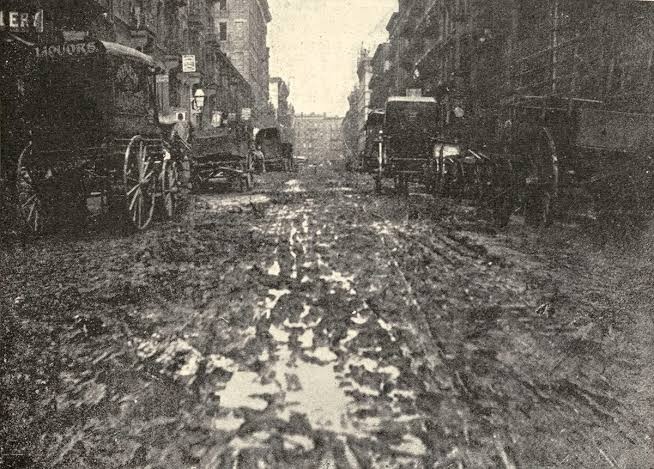Sometimes, you come across a note or a phrase or a reference or an article, that just makes you sit up and say, “What’s that?”
The one such issue was the Horse Manure Problem of 1894.

By the late 1800s, large cities all around the world were dependent on thousands of horses for the transport of both people and goods.
However that was beset with a completely different problem. The cities were “drowning in horse manure”. A 1894 newspaper article from the Times of London had predicted in 50 years, “every street in London will be buried under nine feet of manure.”
There were over 11,000 handsome cabs on the streets of London alone. There were also several thousand horse-drawn buses, each needing 12 horses per day, making a staggering total of over 50,000 horses transporting people around the city each day. To add to this, there were yet more horse-drawn carts and drays delivering goods around what was then the largest city in the world.
New York, which at the time was estimated to be the home of 150,000 horses.
This huge number of horses created major problems. The main concern was the large amount of manure left behind on the streets. On average a horse will produce between 25 and 35 pounds of manure per day, so you can imagine the sheer scale of the problem. This manure produced daily by each beast multiplied by the 150,000+ horses in New York city resulted in more than three million pounds of horse manure per day that somehow needed to be disposed of. That’s not to mention the daily 40,000 gallons of horse urine.
Early in the century, farmers were thrilled to pay good money for the manure but by the end of the 1800s stable owners had to pay to have it carted off. As a result of this glut, vacant lots in cities across America were used to pile manure. Supposedly, New York had 40 to 60 foot mountains of the stuff.

In other words, cities reeked. The “stench was omnipresent.” Urban streets were minefields that needed to be navigated with the greatest care. A new money making gig popped up. Urban streets were manure minefields so crossing sweepers stood on street corners and for a fee they’d clear a path for pedestrians. Wet weather turned the streets into manure rivers, but dry weather turned the manure into dust, which was then whipped up by the wind, choking pedestrians and coating buildings.
The piled up faster than it could be disposed of.. And of course, excess manure led to disease, in particular, outbreaks of typhoid and “infant diarrhea, diseases can be traced to spikes in the fly population. The horse manure is an ideal breeding ground for flies, which spread disease. The deadly outbreaks of typhoid and “infant diarrheal diseases can be traced to spikes in the fly population.” Comparing fatalities associated with horse-related accidents in 1916 Chicago versus automobile accidents in 1997, it was concluded that people were killed nearly seven times more often back in the good old days.
The reasons for this are straightforward.. horse-drawn vehicles have an engine with a mind of its own. The skittishness of horses added a dangerous level of unpredictability to nineteenth-century transportation. This was particularly true in a bustling urban environment, full of surprises that could shock and spook the animals. Horses often stampeded, but a more common danger came from horses kicking, biting, or trampling bystanders. Children were particularly at risk. Falls, injuries, and maltreatment also took a toll on the horses themselves. In 1880, more than 3 dozen dead horses were cleared from New York streets each day (nearly 15,000 a year). Horse carcasses therefore also had to be removed from the streets. The bodies were often left to rot so the corpses could be more easily sawn into pieces for removal.

The terrible situation was debated in 1898 at the world’s first international urban planning conference in New York, but no solution could be found. It seemed urban civilisation was doomed. Urban planners worked for years to come up with an effective cleaning method, but basically cities just lived with the filth.
This sends shivers down my spine. All our cities, especially Mumbai (since I live here) have become so filthy and many a times I shudder at the thought that this city will be full of human faeces and its sanitation system would just crumble one day.
How was the Great Horse Manure Crisis resolved ultimately?
Necessity is the mother of invention, and by 1912, this seemingly insurmountable problem had been resolved and the invention in this case was that of motor transport. Henry Ford came up with a process of building motor cars at affordable prices. Electric trams and motor buses appeared on the streets, replacing the horse-drawn buses and motorised vehicles became the main source of transport and carriage.
(One could argue that this created another problem that we’re still dealing with today)
Here’s a fun final twist - the whole Manure Crisis could have been manufactured by - you guessed it - early car companies to sell more cars! In fact the Reader’s Digest carried an article that attempted to debunk the whole thing: Crisis or Conspiracy?
The Great Horse Manure Crisis of 1894 is, even to this day, used as an analogy for how new technologies can solve problems that appear unsolvable. In the face of a problem with no apparent solution, people often quote ‘The Great Horse Manure Crisis of 1894’, urging people not to despair, something will turn up.
The flip side of that being that it also gives people who don’t want to address a problem a crutch to just assume that some new invention is going to come along and fix things.
Isn’t history fun!
@ Yeshwant Marathe
Thanks: Prashant Naik for initial input.

